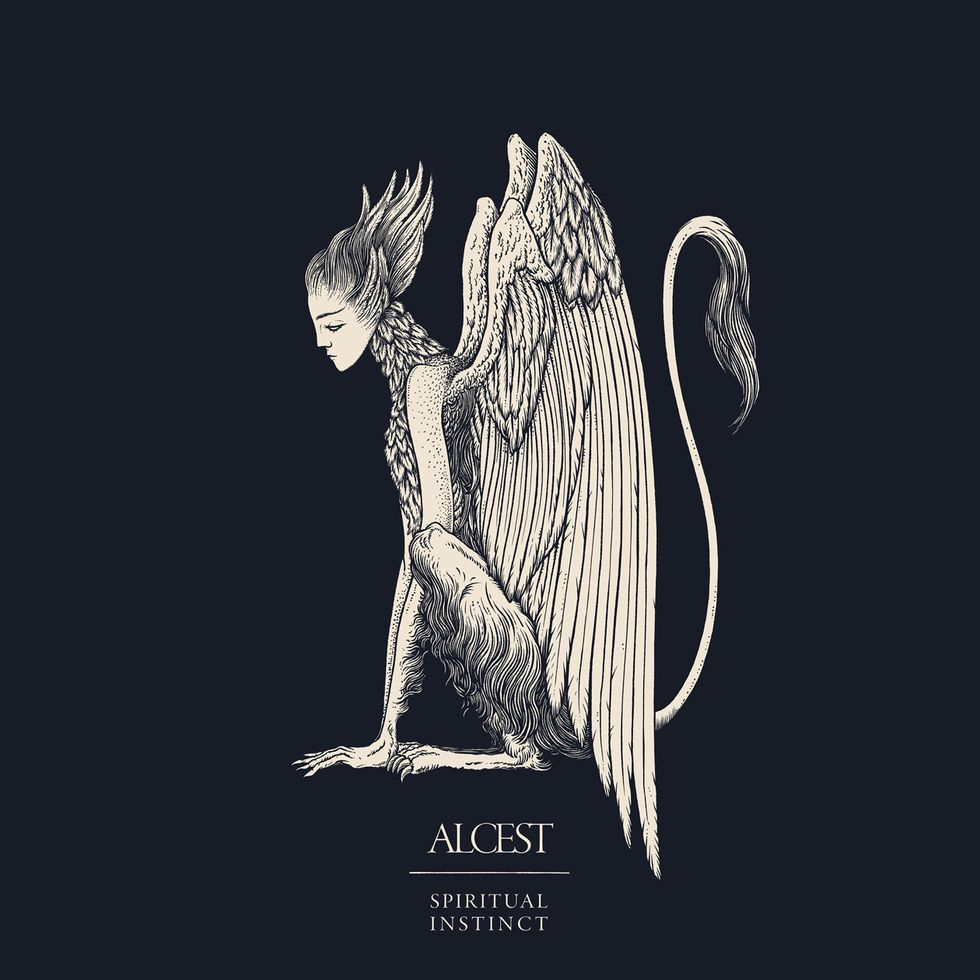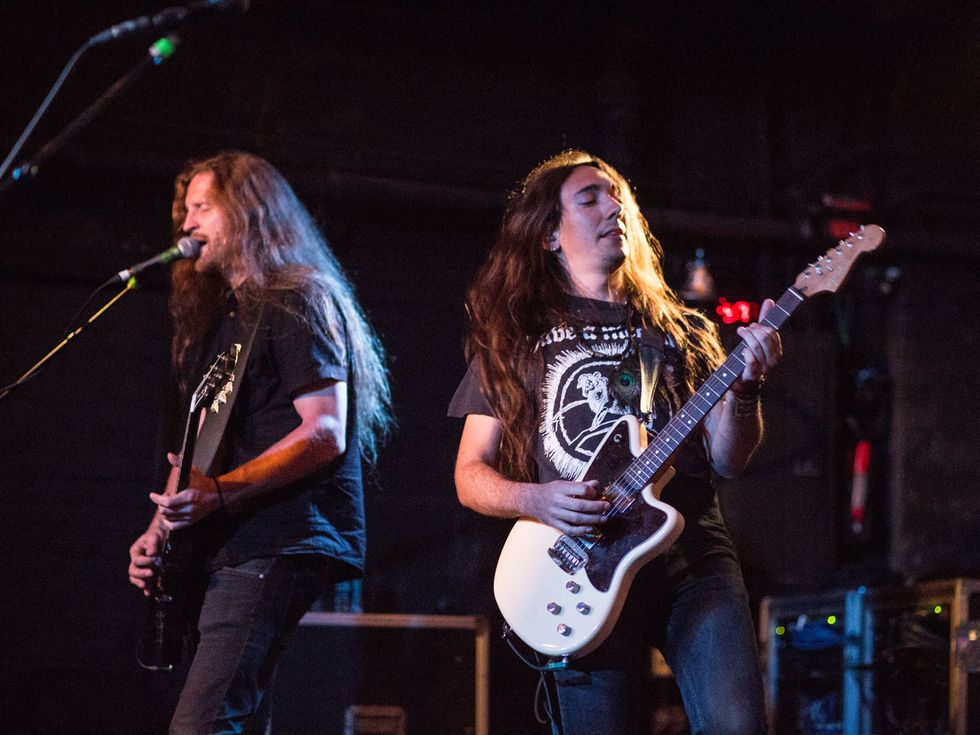At 14 years old, French guitarist Stéphane “Neige” Paut received a supernatural vision of a different place and time. Not knowing how to explain the vision to others, he grabbed his guitar and began translating his experience through the lens of the black metal he loved.
“It was strange, but I was able to remember a different place than where I was in this world,” he says. “Now, I’m living a very normal life, but at the same time, I have a part of myself that is still in this other place.”
Neige named his musical outlet Alcest, and the seeds of blackgaze (fusing elements of black metal and shoegaze) were sown. Thanks to the ominous ambiance of a diverse range of artists, blackgaze has since brought the influence of extreme metal to a massive audience. Not bad for a genre that was initially cast aside by the black metal community. But its rise to global consciousness got its start with Alcest’s 2001 black metal demo, Tristesse Hivernale.
Though the demo gained a substantial following, Neige found black metal’s monochromatic palette unable to illustrate the beauty of his celestial experience. To better communicate what he’d seen, he began tweaking the band’s sound by adding shoegaze-like ethereal passages, memorable melodies, and colorful ambiance. Within a single song, listeners could experience a war of darkness and aggression while simultaneously losing themselves in spacious beauty. Unknowingly, Neige was creating what would be named blackgaze.
“When I started this band, mixing genres was never the goal. It’s just that I grew up with metal and also wanted to do something different in terms of choruses and emotions,” Neige explains. “Actually, when I started Alcest, I didn’t even know about shoegaze.”
But even the new sound began to have its limitations. Not content to be pigeonholed, Alcest’s music moved even further away from its black metal origin, even flirting with indie and alternative rock on 2014’s Shelter. But with 2016’s Kodama, Alcest began rediscovering its black-metal-influenced sound and setting the stage for their latest release, Spiritual Instinct.
A glorious concoction of Alcest’s signature elements, major keys and alternative-rock influences abound on Spiritual Instinct. Swirling reverb and delay wash over every track, and each song delivers surprisingly catchy, sing-along melodies. But the Immortal-approved blast beat on the album’s opening track, “Les jardins de minuit,” signals that this album isn’t all sunshine and rainbows.
An outcome of grinding tour life and Neige’s ongoing battle with anxiety, Spiritual Instinct explodes to life with anger, demonstrating the darker side of his visions. And though it was Kodama that reintroduced these influences, Spiritual Instinct delivers them with a streamlined approach that exemplifies the best in Scandinavian-rooted metal. And that’s by design.
“I listen to a lot of minimalist composers like Philip Glass,” says Neige. “So, for me, simpler music is more direct. It doesn’t have to be super complex to be interesting.”
Complex or not, Spiritual Instinct attempts to demonstrate the balance between the darkness Neige has felt and the beauty he sees. Neige further explains to Premier Guitar this transcendent yin and yang.
How did Alcest start and how did you get to where you are today?
It’s a little bit of a special story. I created this band because when I was younger, I had a spiritual experience. I had some visions coming to me. I could remember the place where I was before being here. I know it sounds a bit strange. I had some memories from a place that doesn’t look like anything we know. I didn’t know what it was. For many years, I didn’t know what to do with [the memories] because it’s obviously not something that’s super common. I felt quite lonely. So, I decided to start a music project to be able to speak about it. That’s Alcest.
I started it when I was 14 or 15. I’m 34 now. It was a teenager’s project for 10 years. I was alone in the project for 10 years, and then in 2009 a drummer (Jean “Winterhalter” Deflandre) joined the project. We started to play live in 2010. Onstage, we have two extra members (Pierre “Zero” Corson on guitar/backing vocals, and Indria Saray on bass).
Initially, you were part of the European black metal scene. But your sound has shifted quite dramatically over the years.
I had a metal background, so that’s what I knew. The first Alcest tape is black metal. But very quickly I changed to something else because black metal wasn’t enough for me. I didn’t want to be a Darkthrone copycat. I had something to say. I wanted to say it in a very personal way.

Alcest’s sixth studio album, Spiritual Instinct, was recorded to tape over a period of three months with a “purist approach” of just guitar, bass, drums, and vocals. Neige’s tonal recipe is to make his Jazzmaster sound like a humbucker guitar by using an Electro-Harmonix Big Muff, a Fulltone OCD, and a Marshall JMP.
The concept and message that [black metal] has is completely the opposite of mine. The place that I wanted to portray is very beautiful, otherworldly, and ethereal. It’s not some creepy forest with demons and stuff. That’s why the music was very fragile, luminous, and ethereal. The black metal people, they didn’t know what to do with us. Now you have bands like Deafheaven. But back then, it was a completely new sound.
So the sonic shifts were to better illustrate your visions and memories?
Yes. Maybe if I grew up listening to classical music, my music would’ve been classical. But I got into metal. I thought it was a very interesting type of music and very powerful. I thought, “Why not use this music?” But instead of speaking about negativity, hate, and stuff like that, I would use very different types of imagery and messages. What I wanted to evoke was a very heavenly place. It has nothing to do with the metal clichés.
You have an immensely personal connection with your subject matter. Are you the sole composer in the band?
I write everything in the music and the lyrics. I’m a drummer, too. So, we work on the drums together. Winterhalter has a very good ear and very interesting opinions. We don’t necessarily listen to the same types of bands. What he has to say is always very interesting. It’s usually something that I would’ve never thought of. So, I listen to what he has to say about my songs.
Throughout Spiritual Instinct, I hear influences as diverse as Emperor, Sonic Youth, and even Isis. Who are your guitar influences?
Actually, I don’t listen to a lot of hard rock. I’m more into melodic types of music. I’m not so much into guitar heroes. For example, I love J Mascis from Dinosaur Jr. I really like Robert Smith from the Cure. I’m a big Cure fan. I love Billy Corgan from the Smashing Pumpkins, too. What he did on the first Pumpkins records is incredible. I also listen to a lot of new wave and indie rock.
Where did you get your black metal influence?
I was into black metal when I was 14. I didn’t do this rock, then heavy metal, then thrash metal, then black metal evolution. I was listening to everything on the radio. Then a friend of mine showed me black metal, and it was love at first sight.
I was listening to the first Emperor album, In the Nightside Eclipse. I didn’t know that such music even existed. It took me away from down-to-earth reality. What you see on the cover is what you have in your mind when you listen to the music. You’re transported to this dark fantasy, dark-side-of-nature type of place that I was really into. With the experience I had, I was attracted to things that took me away from reality.
Shown here on tour in 2015, Neige and co-guitarist Pierre “Zero” Corson work together to fully realize the complexity of Alcest’s cinematic songs in a live format. Photo by Tim Bugbee
Your sound quickly moved on from black metal, but your last album, Kodama, brought some of that feel and aggression back. And now, Spiritual Instinct picks up where that left off. Why bring it back?
It’s related to how I’ve been feeling these past few years. I’m kind of an anxious person. I struggle a lot with anxiety. When we were touring for Kodama, I was really exhausted. Touring is nonstop, and you’re away from your home. And you’re even away from yourself because you can’t be alone for a second. You lose touch with who you are. So, when I started to write new music for Spiritual Instinct, I realized that what I had to say was much angrier and much darker.
What separates Spiritual Instinct from Kodama?
Kodama was more or less a concept album. It was inspired by a movie called Princess Mononoke, by a Japanese filmmaker named Hayao Miyazaki. The concept is about the fight between the natural world and the human world. So, the album is about this and the love I have for Japan. It’s not entirely connected to the real Alcest concept.
Spiritual Instinct has come back to my main idea of a way to express my views on spirituality. And this album is a little bit more in your face. All the songs are very different. We have a song that sounds almost like a pop song. Then we have this very cinematic track and then something way more metal.
The album sounds incredibly full, but there aren’t layers. How did you achieve such a huge sound?
This music doesn’t have a lot of elements. It’s just guitar, bass, drums, and vocals. In the studio, we really tried to find the best possible sound with this limited palette. And I’m not into crazy effects. My pedalboard is really simple. I’m more interested in pure songwriting than effects.
Maybe it’s because of my classical training, but I think if you play the song with an acoustic guitar, it still has to sound great. We always have this very purist approach in the studio. For example, we spent a week just to find the guitar sound.
In a Facebook post, you said, “Recording it was a long and challenging process.” Why was that, and can you take me through the process?
Everything was on tape. It’s a much stronger and more complicated process. Sometimes you have to wait for keying the machine and stuff. And we were not 100 percent ready to go to the studio this time, but we were being pushed a little bit to get in there. It’s not a good idea to go to the studio and not feel completely ready.
Everything combined made us stay for three months. Three months for 40 minutes of music … it’s a bit much. Sometimes you just lose your mind.
How were you able to expand your playing and writing on Spiritual Instinct?
This album is more direct, and the songs came to me in a much faster way than usual. Usually, I find a few riffs, and I put them together. It takes ages for me to finish a song because I’m a perfectionist, and I work on details. This time, for example, the single of “Protection” was written in just a few hours, and I didn’t change anything. That was very refreshing.
As a musician, you’re always looking for this very genuine and very pure type of inspiration. Something that just comes to you. That’s what happened with this album. It came to me very, very quickly, and I thought it would be cool just to leave it as it is and not try to make it more complicated than it is.
You often play Jazzmasters and other offset-style guitars. What draws you to them, and did you use them on the album?
There are guitars, and then there’s the Jazzmaster. It’s quite difficult to play, the neck is really long, and it’s very precise. You hear everything on the Jazzmaster. I really love this instrument. It really sings, and that’s the instrument I’ve been using to write my songs. Mine’s an American Vintage. I bought it in 2012. In the newer Jazzmaster series, I didn’t find any guitar that was like it. Maybe I got pretty attached to this specific guitar. But one day I want to own a vintage Jazzmaster.
Unfortunately, I can’t use the Jazzmaster live because it just makes too much feedback. I don’t want to use a noise gate, so live I use a [Fender] Toronado from ’98. I’ve seen a few guys playing this guitar. I was like, “What the heck is that? I’ve never seen it before.” I love the shape, and I think it’s a little bit in between a Gibson and a Fender.

Guitars
2012 Fender American Vintage Jazzmaster
1998 Fender Toronado
Amps
1970s Marshall JMP Super Lead (studio)
Marshall JVM410H (live)
Roland JC-120
Fender ’65 Twin Reverb Reissue
Marshall 1960 4x12 cab
Effects
Electro-Harmonix Big Muff
Fulltone OCD
TC Electronic Hall of Fame Reverb
Boss DD-3 Digital Delay
TC Electronic outboard delay/reverb
Strings and Picks
Ernie Ball Skinny Top Heavy Bottom (.010—.052)
Dunlop Tortex .88 mm Green
How do you get such a big sound from a Jazzmaster in the studio?
The challenge is to make the Jazzmaster sound like a humbucker guitar. The [Jazzmaster] sound is very transparent. It’s very, very light. To adjust for that, we use a Big Muff. I think it’s the same setting as J Mascis from Dinosaur Jr. And we run it into a Marshall JMP. We also use an OCD. I really love the Fulltone OCD.
The JMP is from the ’70s. It’s a Super Lead. For the clean tones, we use a [Roland] Jazz Chorus. It’s one of my favorite amps. For the reverbs and stuff, it was nothing fancy. I have a TC Electronic Hall of Fame that I really like. It’s not the fanciest reverb in the world, but it does what I’m looking for, which is this aquatic sound. There is this MOD preset on the Hall of Fame that I really like. Just a little delay, and that’s it. I have this very basic [Boss] DD-3. I might sound a little bit disappointing with my pedals. [Laughter.]
Do you track your reverb and delay to tape?
It was a mix of a little bit of reverb to the tape, and then in post-production from a TC Electronic hardware thing. But I don’t remember the name. We used another reverb after the tape to make it sound big.
Do you use the same amps and pedals live?
I’m into having a clean platform and using distortion pedals. Before now, I was going through a Fender Twin Reverb and a Jazz Chorus at the same time. It was sounding really, really cool. But it’s not the same as a Marshall.
I’m really attached to the Marshall sound. It’s a very unique range. It was difficult to recreate using combo amps, so in my setup now I have the Marshall JVM410H. I’m using the clean channel and pedals. It’s really stupid because this amp has four channels I could use, but I’m just using the clean channel for now.
You also played bass on the album. What did you use to get that sound?
It was a Jazz bass that a friend lent us. I think it’s an American Jazz bass. For the amp, it was an Ampeg SVT Classic. We also used a pedal called the Darkglass Microtubes B3K. It was cool for the distortion while not taking any of the bass frequencies.
Your writing balances black-metal aggression, soothing ambiance, and catchy songwriting. Those three things don’t usually go together. How are you able to marry them so naturally?
I don’t like bands that make patchwork songs. For me, if I play a riff that sounds a bit like Smashing Pumpkins and then a riff that sounds a bit like Emperor, there should be a link between them. It should go naturally from one place to another. What I try to do is make [the parts] flow in a natural way where you don’t think about genres.
When it comes to our sets, people have used all the possible genres to describe our music. I tell them, “Forget about the genres. It’s not about the meeting of black metal and shoegaze. That’s just secondary.”
You came to your sound in a very pragmatic way. But there’s no denying that it did spearhead the blackgaze genre. Bands like Deafheaven are doing very well and owe a lot to what you created. How does that make you feel, and do you feel loyalty to the genre?
It’s crazy, man. I prefer not to think so much about it. For me, as I told you, it’s way more than just mixing black metal and shoegaze. There’s a whole concept behind the project. But if people see it as a mix of shoegaze and black metal and it inspires them to make their own thing, I’m very honored. That’s why I prefer not to think about it. I mean, it’s still very underground music.
Neige’s Fender Toronado embraces both dark and light during this live version of “Protection,” off of Alcest’s new album, Spiritual Instinct
















![Rig Rundown: Russian Circles’ Mike Sullivan [2025]](https://www.premierguitar.com/media-library/youtube.jpg?id=62303631&width=1245&height=700&quality=70&coordinates=0%2C0%2C0%2C0)
















![Rig Rundown: AFI [2025]](https://www.premierguitar.com/media-library/youtube.jpg?id=62064741&width=1245&height=700&quality=70&coordinates=0%2C0%2C0%2C0)




















 Zach loves his Sovtek Mig 60 head, which he plays through a cab he built himself at a pipe-organ shop in Denver. Every glue joint is lined with thin leather for maximum air tightness, and it’s stocked with Celestion G12M Greenback speakers.
Zach loves his Sovtek Mig 60 head, which he plays through a cab he built himself at a pipe-organ shop in Denver. Every glue joint is lined with thin leather for maximum air tightness, and it’s stocked with Celestion G12M Greenback speakers.






